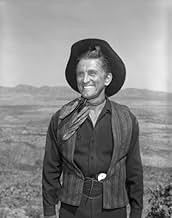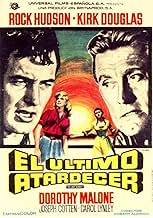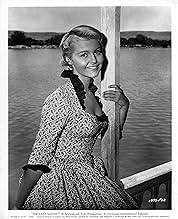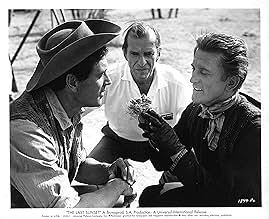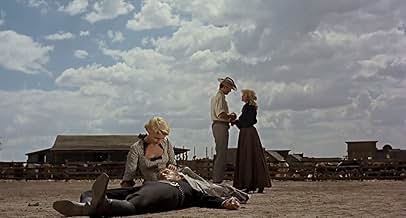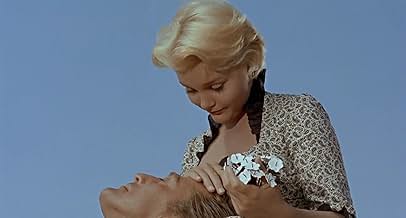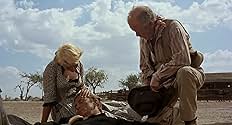CALIFICACIÓN DE IMDb
6.7/10
4 k
TU CALIFICACIÓN
En un rancho mexicano, el fugitivo O'Malley y el sheriff Stribling aceptan ayudar al ranchero Breckenridge a conducir su ganado a las tierras de Texas, donde Stribling podría arrestar a O'Ma... Leer todoEn un rancho mexicano, el fugitivo O'Malley y el sheriff Stribling aceptan ayudar al ranchero Breckenridge a conducir su ganado a las tierras de Texas, donde Stribling podría arrestar a O'Malley.En un rancho mexicano, el fugitivo O'Malley y el sheriff Stribling aceptan ayudar al ranchero Breckenridge a conducir su ganado a las tierras de Texas, donde Stribling podría arrestar a O'Malley.
- Dirección
- Guionistas
- Elenco
- Premios
- 1 nominación en total
James Westmoreland
- Julesburg Kid
- (as Rad Fulton)
Gregorio Acosta
- Singing ranch hand
- (sin créditos)
Manuel Alvarado
- Bartender saloon
- (sin créditos)
José Chávez
- Man at Cock Fight
- (sin créditos)
Arturo Fernández
- Man in saloon
- (sin créditos)
Peter Helm
- Man at Saloon
- (sin créditos)
Regino Herrera
- Man in saloon
- (sin créditos)
- Dirección
- Guionistas
- Todo el elenco y el equipo
- Producción, taquilla y más en IMDbPro
Opiniones destacadas
An unpretentious Western told in an honest, straightforward manner.
Robert Aldrich does a very controlled job directing a story straddling the Texas Mexico border, a story told at a steady pace but rarely reaching memorable highs. The film has many elements of the classic Western including a chase, cattle drive and gunfight but it also tries to add some melodramatic, pure story based elements - though one major plot point was so well signposted, it might as well have been included in the opening credits.
Kirk Douglas, as Brendan O'Malley, provides the barely controlled dynamism at the centre of the film. Unfortunately, not all parts of the film are to this standard. Rock Hudson has difficulties with the role of the upstanding sheriff. A strong supporting cast, from Joseph Cotton to Jack Elam, provides a wide, interesting range of characters.
Overall, a solid if unspectacular film, recommended for Western and Kirk Douglas fans. 6.75.
Robert Aldrich does a very controlled job directing a story straddling the Texas Mexico border, a story told at a steady pace but rarely reaching memorable highs. The film has many elements of the classic Western including a chase, cattle drive and gunfight but it also tries to add some melodramatic, pure story based elements - though one major plot point was so well signposted, it might as well have been included in the opening credits.
Kirk Douglas, as Brendan O'Malley, provides the barely controlled dynamism at the centre of the film. Unfortunately, not all parts of the film are to this standard. Rock Hudson has difficulties with the role of the upstanding sheriff. A strong supporting cast, from Joseph Cotton to Jack Elam, provides a wide, interesting range of characters.
Overall, a solid if unspectacular film, recommended for Western and Kirk Douglas fans. 6.75.
Major portions of this movie were filmed on my grandfather's ranch "La Presa" in Aguascalientes, Mexico. My family and the locals still remember the excitement of hosting Hollywood stars and a film crew in such an unlikely place. Throughout the film the actors make factually correct references to the local villages and towns. And although most of these people only viewed the movie once (during its initial run in 1961) they remember the plot and the excitement of hearing the names of their villages uttered by stars on the big screen. And while Aguascalientes cannot claim to be a cult destination a la "Giant" (Rock Hudson again), they remain proud of their footnote in film history.
I personally recall the loud arguments my father (living in the USA at the time) would have with his cousin Salvador, who swore that Rock Hudson had been seen in town with the local (and few) homosexuals. In 1961, my father believed that it was impossible for Rock to be anything but the All-American (straight) male image he projected on the screen. My dad laughs about it now.
I personally recall the loud arguments my father (living in the USA at the time) would have with his cousin Salvador, who swore that Rock Hudson had been seen in town with the local (and few) homosexuals. In 1961, my father believed that it was impossible for Rock to be anything but the All-American (straight) male image he projected on the screen. My dad laughs about it now.
The one and only teaming of Kirk Douglas and Rock Hudson in The Last Sunset was a fortunate one. Kirk's production company Bryna put this film together and the wise Kirk knew what he was doing when he took the flashier and meatier part of the villain.
In that regard The Last Sunset is similar to Gunfight at the OK Corral where the straight arrow hero of Wyatt Earp played by Burt Lancaster took a definite second place to Douglas's Doc Holiday. As Brendan O'Malley, Douglas is one devilishly charming one with the ladies and fast on the draw as all get out.
In fact Douglas's libido seems to get him in a whole lot of trouble. It's the reason that sheriff Dana Stribling played by Rock Hudson is down and out of his jurisdiction in Mexico chasing O'Malley. It's more than a job with Stribling as you'll see in the film.
While in Mexico Douglas meets an old flame of his, Dorothy Malone there with her husband Joseph Cotten and daughter Carol Lynley. Both he and Hudson strike an unusual bargain with the family. They'll aid them in their cattle drive to the American side of the Rio Grande, but then Douglas and Hudson will have it out.
Sounds crazy, but all will be revealed to the viewer before the film is over, although I'm sure some will guess.
Hudson got the far less glamorous part of a straight law and order sheriff. He has his moments, but the film really turns on the personality and charm and considerable talent of Kirk Douglas. This is definitely one of his top ten performances on film. Sad it isn't shown more often.
Dorothy Malone was doing very well around this time as a portrayer of western women. Her career really took off after that Oscar in Written on the Wind. She's the epitome of a strong willed pioneer woman who had to bend a few conventions to survive.
The Last Sunset is a great western, the usual amount of traditional western activity with some very adult themes in this which I just can't reveal lest it ruin one's viewing.
In that regard The Last Sunset is similar to Gunfight at the OK Corral where the straight arrow hero of Wyatt Earp played by Burt Lancaster took a definite second place to Douglas's Doc Holiday. As Brendan O'Malley, Douglas is one devilishly charming one with the ladies and fast on the draw as all get out.
In fact Douglas's libido seems to get him in a whole lot of trouble. It's the reason that sheriff Dana Stribling played by Rock Hudson is down and out of his jurisdiction in Mexico chasing O'Malley. It's more than a job with Stribling as you'll see in the film.
While in Mexico Douglas meets an old flame of his, Dorothy Malone there with her husband Joseph Cotten and daughter Carol Lynley. Both he and Hudson strike an unusual bargain with the family. They'll aid them in their cattle drive to the American side of the Rio Grande, but then Douglas and Hudson will have it out.
Sounds crazy, but all will be revealed to the viewer before the film is over, although I'm sure some will guess.
Hudson got the far less glamorous part of a straight law and order sheriff. He has his moments, but the film really turns on the personality and charm and considerable talent of Kirk Douglas. This is definitely one of his top ten performances on film. Sad it isn't shown more often.
Dorothy Malone was doing very well around this time as a portrayer of western women. Her career really took off after that Oscar in Written on the Wind. She's the epitome of a strong willed pioneer woman who had to bend a few conventions to survive.
The Last Sunset is a great western, the usual amount of traditional western activity with some very adult themes in this which I just can't reveal lest it ruin one's viewing.
As always an incredible performance by Kirk Douglas as an outlaw/ drifter on a quest to meet his great love. He's being chased by a Texas lawman played by Rock Hudson. Despite the venue, horses, cattle drive and Mexicans this isn't really a western IMHO. It's a love story draped with western gear. Jack Elam & Neville Brand are essentially wasted. Joseph Cotten as the husband of Douglas' lost love is a sympathetic drunk who gets the kind of back draw justice you might in a Mexican bar. Carol Lynley is beautiful as Dorothy Malone's daughter and Kirk's replacement love interest. The tale feels like it has Biblical elements to it on it's most important level. Ultimately it's worth watching for Kirk's performance whether angry, charming or in love. The crime of which he is accused is clearly just a plot device to get everybody together. I just kept wondering how hot it must be dressed in black in Mexico on a cattle drive?
Enemies Bren O'Malley and Dana Stribling confront each other in Mexico, and are then hired by the Breckenridge family to help drive a herd of cattle north to Texas. The two men observe a truce which will last until they have crossed the Rio Grande, but at sunset on the first day back in Texas, there will be a reckoning. For one of them, it will be the last sunset.
Made in 1961, this film is a fine example of an art form that was dying - the 1950's western. John Wayne carried on making them for a few years more (and arguably up to "The Shootist"), but by 1964, three years after this picture, the Spaghetti Western had arrived, and the genre was transformed for ever. The 1950's in Europe and America was an era of social stability - some would say stagnation - and the western reflected the values of the rigid, disciplined society which produced it. Plots did not vary much, innovation not being something that audiences craved, and storylines turned on predictable devices like cattle stampedes, indians on the skyline, fast draws and a man doing what a man's got to do. This film happens to contain all of these stock ingredients.
Man's desire for woman is a theme running through the story in deftly-worked permutations. Dalton Trumbo's better than average script has older men lusting after younger women, men harbouring fantasies of lost love, bad guys leering at decent matrons, and much more. Belle is made a chattle in her husband's droving contract, and receives a new proposal of marriage under the flying buttresses of a Mexican church. In keeping with the film's symbolic structure, she reserves her response until the Rio Grande has been crossed (Mexico seems to preserve the Americans in aspic, preventing them from advancing their plans, just as the church architecture encloses Belle and her lover).
"The Last Sunset" is several cuts above the average western. Its plot situation, the pursuit of one man by another and the involvement of a ranching family, is neatly established at the outset with minimal dialogue. The immediate sexual electricity between O'Malley and Belle engages the viewer, and O'Malley's little comic touches convey his charm and 'open him up' for the viewer. Belle's inner conflict is quickly made plain for us, and O'Malley's behaviour (graciously allowing her to leave the barn) is psychologically interesting, suggesting that he is certain of her. We want to know more about these characters. Much is achieved with the merest of glances, as when Breckenridge tells O'Malley "everything that's mine is yours", and O'Malley darts a look at Belle, or the glance thrown by Stribling when he realises why O'Malley is taking the appalling risk of returning to Texas.
Expert editing by Michael Luciano enhances the effectiveness of the movie considerably. When O'Malley teaches the Julesburg Kid a lesson on horseback, elliptical cutting skilfully evokes the Kid's sense of dizziness and confusion. At the final shoot-out, the accelerating rapidity of the cuts increases the tension brilliantly. There is one small lapse at the start of the cattle drive - the pick-up shot of O'Malley fording the river (overcast sky) does not match the master shot (bright sunshine).
O'Malley's song, "Pretty Girl In The Yellow Dress", runs through the film as a motif. It is a central symbol, because O'Malley's idealistic and doomed vision of Belle is transferred to Missy when she dons the dress - "a new smell to follow".
Admirable though it is, the film does have some weak points. Would Breckenridge REALLY accept O'Malley's second precondition? Would the wily O'Malley REALLY shoot the indian so rashly? The grassy bank on which O'Malley and Missy recline is patently a studio fabrication, bearing no resemblance to the parched earth of the location shots. Stribling's final comment on the derringer is clumsy overkill. We all got the point.
Good use is made of locations, especially old Spanish architecture like the crumbling aqueduct. The brick arches seem to be enveloping the Americans, just as their lives are stalled by being here in Mexico. Attractively-shot silhouettes adorn the dust-storm sequence, particularly during the quicksand episode. Once back in Texas, O'Malley is emblematically shut in by corral fences, a man left with nowhere to go. The film's great punchline, delivered by Belle on the verandah, is truly shocking.
Kirk Douglas and Rock Hudson, O'Malley and Stribling respectively, appear above the title (Douglas's own production company, named after his mother, financed the picture). Douglas is appealing and charismatic in one of his many 'generous-hearted bad guy' roles. Hudson is perfectly adequate in the straight-down-the-line part of Stribling, and looks terrific. The character of Belle, with her internal contradictions and the aura of having been buffeted by life, calls for an actress with both beauty and intelligence. Dorothy Malone is ideal in the role. Carol Lynley does very well as Missy, making a great transition from gawky kid to radiant woman. If Joseph Cotten fails to shine, it must be said that the part of Breckenridge is a dreary one. Neville Brand and Jack Elam turn in stock performances: as jobbing bad guys throughout the 1950's and early 60's, they must hardly ever have needed to shave.
Verdict - Interesting western with powerful denouement.
Made in 1961, this film is a fine example of an art form that was dying - the 1950's western. John Wayne carried on making them for a few years more (and arguably up to "The Shootist"), but by 1964, three years after this picture, the Spaghetti Western had arrived, and the genre was transformed for ever. The 1950's in Europe and America was an era of social stability - some would say stagnation - and the western reflected the values of the rigid, disciplined society which produced it. Plots did not vary much, innovation not being something that audiences craved, and storylines turned on predictable devices like cattle stampedes, indians on the skyline, fast draws and a man doing what a man's got to do. This film happens to contain all of these stock ingredients.
Man's desire for woman is a theme running through the story in deftly-worked permutations. Dalton Trumbo's better than average script has older men lusting after younger women, men harbouring fantasies of lost love, bad guys leering at decent matrons, and much more. Belle is made a chattle in her husband's droving contract, and receives a new proposal of marriage under the flying buttresses of a Mexican church. In keeping with the film's symbolic structure, she reserves her response until the Rio Grande has been crossed (Mexico seems to preserve the Americans in aspic, preventing them from advancing their plans, just as the church architecture encloses Belle and her lover).
"The Last Sunset" is several cuts above the average western. Its plot situation, the pursuit of one man by another and the involvement of a ranching family, is neatly established at the outset with minimal dialogue. The immediate sexual electricity between O'Malley and Belle engages the viewer, and O'Malley's little comic touches convey his charm and 'open him up' for the viewer. Belle's inner conflict is quickly made plain for us, and O'Malley's behaviour (graciously allowing her to leave the barn) is psychologically interesting, suggesting that he is certain of her. We want to know more about these characters. Much is achieved with the merest of glances, as when Breckenridge tells O'Malley "everything that's mine is yours", and O'Malley darts a look at Belle, or the glance thrown by Stribling when he realises why O'Malley is taking the appalling risk of returning to Texas.
Expert editing by Michael Luciano enhances the effectiveness of the movie considerably. When O'Malley teaches the Julesburg Kid a lesson on horseback, elliptical cutting skilfully evokes the Kid's sense of dizziness and confusion. At the final shoot-out, the accelerating rapidity of the cuts increases the tension brilliantly. There is one small lapse at the start of the cattle drive - the pick-up shot of O'Malley fording the river (overcast sky) does not match the master shot (bright sunshine).
O'Malley's song, "Pretty Girl In The Yellow Dress", runs through the film as a motif. It is a central symbol, because O'Malley's idealistic and doomed vision of Belle is transferred to Missy when she dons the dress - "a new smell to follow".
Admirable though it is, the film does have some weak points. Would Breckenridge REALLY accept O'Malley's second precondition? Would the wily O'Malley REALLY shoot the indian so rashly? The grassy bank on which O'Malley and Missy recline is patently a studio fabrication, bearing no resemblance to the parched earth of the location shots. Stribling's final comment on the derringer is clumsy overkill. We all got the point.
Good use is made of locations, especially old Spanish architecture like the crumbling aqueduct. The brick arches seem to be enveloping the Americans, just as their lives are stalled by being here in Mexico. Attractively-shot silhouettes adorn the dust-storm sequence, particularly during the quicksand episode. Once back in Texas, O'Malley is emblematically shut in by corral fences, a man left with nowhere to go. The film's great punchline, delivered by Belle on the verandah, is truly shocking.
Kirk Douglas and Rock Hudson, O'Malley and Stribling respectively, appear above the title (Douglas's own production company, named after his mother, financed the picture). Douglas is appealing and charismatic in one of his many 'generous-hearted bad guy' roles. Hudson is perfectly adequate in the straight-down-the-line part of Stribling, and looks terrific. The character of Belle, with her internal contradictions and the aura of having been buffeted by life, calls for an actress with both beauty and intelligence. Dorothy Malone is ideal in the role. Carol Lynley does very well as Missy, making a great transition from gawky kid to radiant woman. If Joseph Cotten fails to shine, it must be said that the part of Breckenridge is a dreary one. Neville Brand and Jack Elam turn in stock performances: as jobbing bad guys throughout the 1950's and early 60's, they must hardly ever have needed to shave.
Verdict - Interesting western with powerful denouement.
¿Sabías que…?
- TriviaThis movie had a major influence on Sergio Leone, who worked with director Robert Aldrich on Sodom and Gomorrah (1962).
- ErroresTwo of the dresses worn by Missy (the yellow one and the floral one in town) have zippers up the back. Not a goof: women's clothing in the 1880s was fastened with a series of hook-and-eyes attached to twill tape. The way this tape was sewn into dress and skirts is the same way modern zippers are sewn.
- Citas
Belle Breckenridge: To me, it always seems like it's the women who keep on living. Men kill or get killed and women bury them. We're professional survivors.
- ConexionesFeatured in Rock Hudson's Home Movies (1992)
- Bandas sonorasPretty Little Girl In The Yellow Dress
Music - Dimitri Tiomkin
Lyric - Ned Washington
Performed by Kirk Douglas (uncredited)
Selecciones populares
Inicia sesión para calificar y agrega a la lista de videos para obtener recomendaciones personalizadas
- How long is The Last Sunset?Con tecnología de Alexa
Detalles
Taquilla
- Presupuesto
- USD 3,500,000 (estimado)
- Tiempo de ejecución1 hora 52 minutos
- Relación de aspecto
- 1.85 : 1
Contribuir a esta página
Sugiere una edición o agrega el contenido que falta

Principales brechas de datos
What is the French language plot outline for El último atardecer (1961)?
Responda

